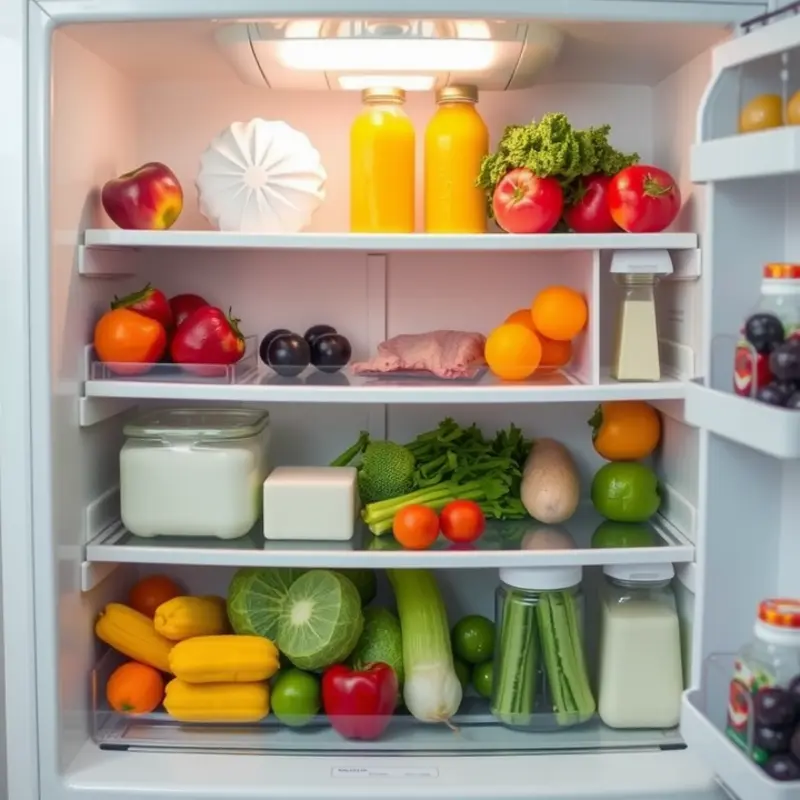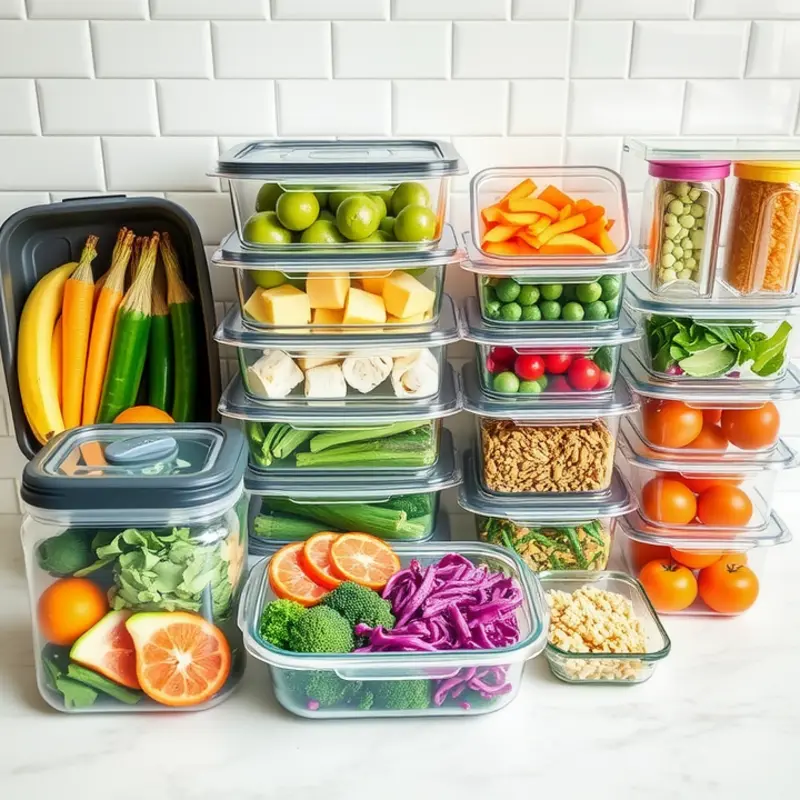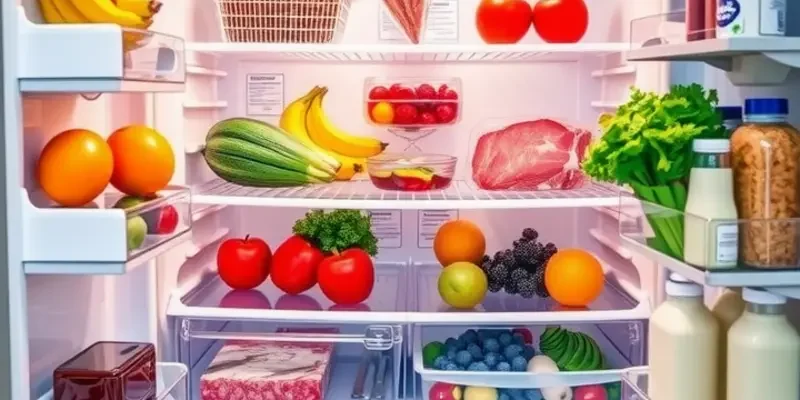Effectively organizing your refrigerator is crucial for maintaining food freshness, maximizing space, and reducing waste. With simple methods and a few practical tips, you can optimize your food management at home. Understanding how to store ingredients correctly not only extends their shelf life but also encourages meal planning, minimizes spoilage, and ultimately reduces food waste. Discover how to create an efficient and inviting refrigerator that saves you time and money.
The Basics of Fridge Organization: Zones and Temperature Control

Understanding how to effectively organize your fridge can significantly impact food freshness and reduce waste. Your fridge consists of different zones, each with varying temperatures and airflow, requiring specific attention to maximize efficiency.
Firstly, let’s dissect the fridge into its primary zones. The top shelves are typically the warmest, making them suitable for already cooked food, herbs, and foods like yogurt. Middle shelves are ideal for dairy products such as milk and cheese, where consistent temperature is crucial to maintaining their freshness. Lower shelves are generally the coldest part due to their proximity to the cooling system, making them ideal for storing raw meat, poultry, and fish. Always store these in sealed containers to prevent cross-contamination.
Crisper drawers play a vital role for produce, divided into high and low humidity compartments. High-humidity drawers are perfect for leafy greens and vegetables that tend to wilt, as added moisture will keep them fresh longer. Low-humidity drawers are ideal for fruits that require drier environments to stay crisp.
The fridge door may seem convenient, but it’s actually the warmest spot and experiences frequent temperature fluctuations. Limit this space to condiments, juice, and other non-perishable items. Avoid storing milk or eggs here, as they rapidly spoil with temperature inconsistencies.
Another crucial aspect of fridge organization is mastering temperature control. Ideally, your fridge should be set at or below 40°F (4°C). This temperature inhibits bacterial growth while preserving food quality. Regularly verify the thermostat settings and use a thermometer to ensure accuracy.
Aligning with temperature settings, airflow should not be obstructed. Avoid overcrowding, as it restricts cold air circulation and may cause uneven cooling. Instead, employ a first-in, first-out system by placing newer items at the back and older items at the front to encourage consumption and reduce waste.
Recognize the importance of maintaining cleanliness and minimize clutter. Periodically remove expired items and wipe down surfaces to prevent spills from contaminating other foods. Creating a straightforward labeling system with dates and contents for containers can also help keep track of food freshness.
For insights on minimizing food waste in your kitchen organization further, consider exploring eco-smart kitchen storage. This resource can offer additional guidance on reducing your kitchen’s environmental impact.
Adopting these strategic zoning and temperature management practices transforms your fridge into an efficient machine, conserving both energy and resources. Effectively organized, your fridge not only extends the life of your food but enhances ease of use, leading to healthier and more conscious eating habits.
Smart Strategies for Food Storage and Waste Reduction

Keeping food fresh is a vital aspect of efficient fridge management that not only ensures food safety but also significantly reduces waste. Utilizing the right wrapping techniques is a perfect place to start. Proper wrapping can extend the life of your perishables. Consider airtight methods, such as using beeswax wraps, food-safe silicone bags, or simply ensuring that all containers are sealed tightly. Wrapping is especially crucial for items prone to spoilage like fresh produce and cheeses.
Clear containers play a central role by making contents easily identifiable, reducing the likelihood of food being forgotten and spoiling. When you can see exactly what’s inside, you’re more likely to use it before expiration. Storing food in transparent glass or BPA-free plastic containers allows you to quickly spot leftovers, ensuring they don’t get pushed to the back and wasted.
Labeling these containers is equally important. Include dates to track how long food has been stored, thereby managing consumption priorities better. This simple practice helps you plan meals efficiently around what is on hand, reducing unnecessary duplicates while shopping.
Another smart strategy is to allocate specific fridge zones for certain types of food. Designate the bottom shelf for raw meats, poultry, and seafood—ideally contained to prevent cross-contamination. Store dairy products on the middle shelves where the temperature is most consistent. These practices not only preserve the integrity of your food but also optimize safety.
Meal planning can further minimize waste if thoughtfully executed. Start by taking stock of what you already have before making a shopping list. This approach encourages you to create meals that incorporate aging produce, ensuring it’s consumed before spoilage. An insightful resource on minimal prep dinner ideas could help maximize the ingredients you own without unnecessary complexity.
An additional storage hack is employing the use of a “first in, first out” (FIFO) system. Position older items in the front of your fridge and pantry, prompting their use before newer purchases. This technique is beneficial in managing pantry items as well.
Finally, understanding the natural properties of certain foods can extend their shelf life. For instance, onions and potatoes should be stored separately due to gases that speed decay when combined. Additionally, storing fruits like apples and bananas separately is wise as bananas emit ethylene gas, which hastens ripening.
Implementing these strategies can seamlessly integrate into your routine, transforming how you manage your fridge. It’s about creating a system that not only supports efficient storage but also fosters mindful consumption, contributing to a more sustainable lifestyle.
Final words
Efficient fridge organization is accessible and beneficial for any home. By understanding the unique zones of your refrigerator and employing smart storage strategies, you can effectively reduce food waste and maintain the longevity of your groceries. Take the time to set up your fridge thoughtfully, and enjoy the added bonus of less stress during meal preparation. Remember, a well-organized fridge not only reflects an organized lifestyle but also contributes to healthier eating habits.







